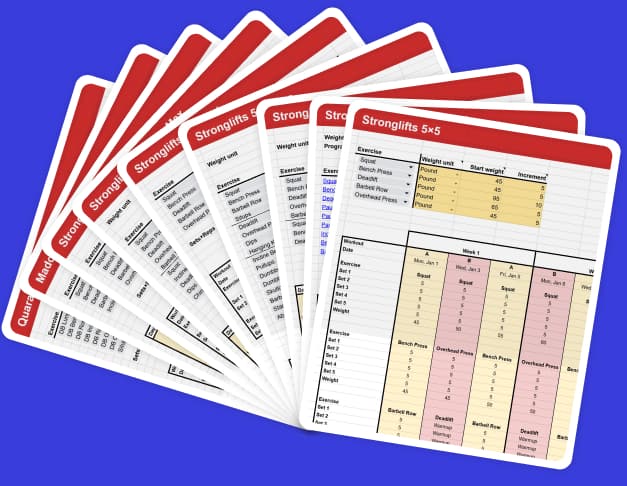Stronglifts 5×5 Mini is a strength and muscle maintenance program for busy lifters. It’s a short, low volume variation of Stronglifts 5×5.
Stronglifts 5×5 Mini is designed for busy lifters who have reached their desired levels of strength and muscle size. The program helps you maintain strength and hypertrophy using short, minimal workouts that don’t take much time.
In this guide I’ll show you how Stronglifts 5×5 Mini works.
Contents
- Stronglifts 5×5 Mini program overview
- Stronglifts 5×5 Mini FAQs
- Can I maintain strength with this?
- Can I maintain muscle with this?
- How long can I expect to maintain?
- How to switch to Stronglifts 5×5 Mini?
- Why no Squats in workout B?
- Why no Barbell Rows?
- Can I add assistance work?
- Can I do this once per week?
- Can I just do one set?
- How should I progress?
- How to go back to Stronglifts 5×5?
- Are there program variations?
- Is there a spreadsheet for Stronglifts 5×5 Mini?
- References
Join the Stronglifts community to get free access to all the spreadsheets for every Stronglifts program. You’ll also get 17% off Stronglifts Pro, and daily email tips. Enter your email below to sign up today for free.
Stronglifts 5×5 Mini program overview
The Stronglifts 5×5 Mini program looks exactly like Stronglifts 5×5. But you only do two exercises per workout, and two sets per exercise.
| StrongLifts 5×5 Mini | |
|---|---|
| Workout A | Workout B |
| Squat 2×5 | Deadlift 2×5 |
| Bench Press 2×5 | Overhead Press 2×5 |
2×5 means two sets of five reps. You first warmup by doing gradually heavier sets of five reps until you reach your working weight for the exercise. You then do two sets of five reps with that work weight.
Workout schedule
With Stronglifts 5×5 Mini you do two or three workouts a week with at least one rest day in between. Alternate workout A and B every gym session.
Let’s say you train 3x/week on Monday, Wednesday and Friday. Here’s how your schedule would look like on Stronglifts 5×5 Mini…
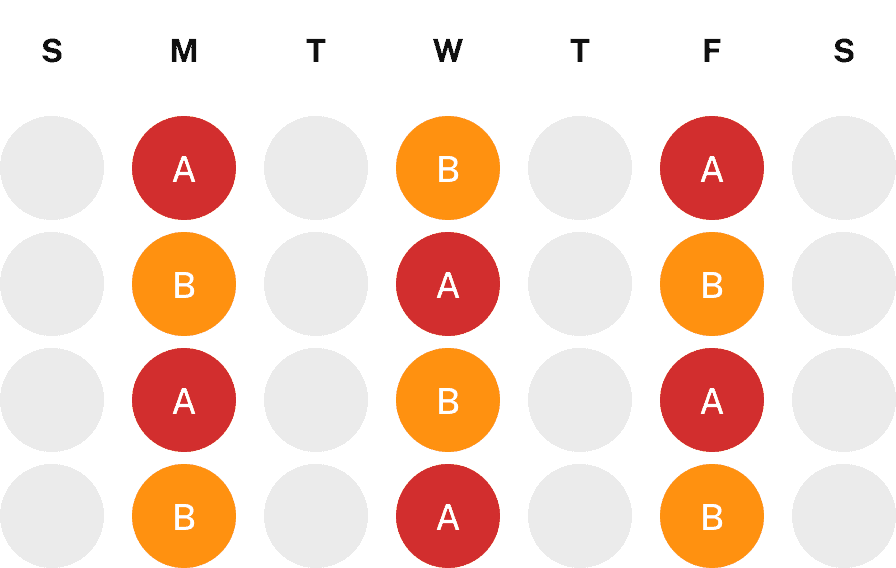
If you don’t have time to do three workouts a week, you could do Stronglifts 5×5 Mini 2x/week instead. Here’s an example schedule where you’d train every Monday and Thursday…
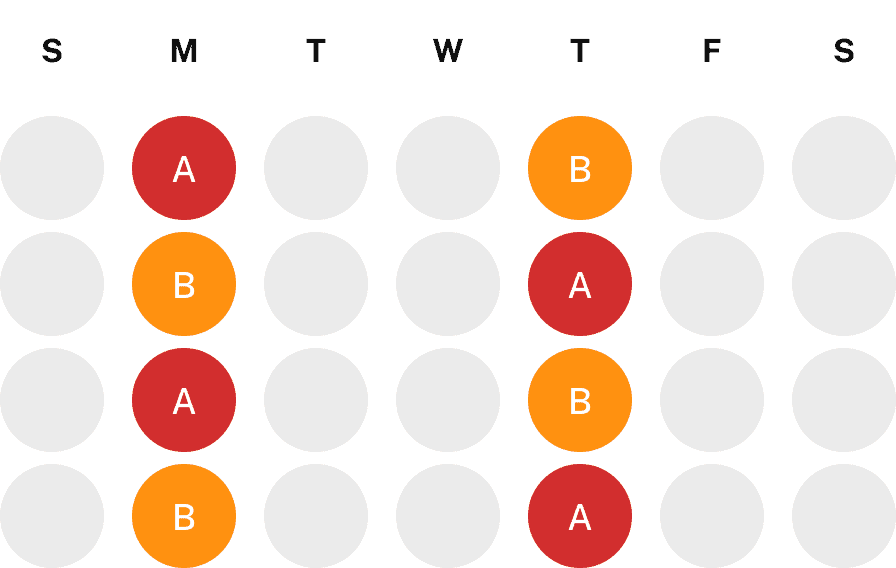
You can log Stronglifts 5×5 Mini using the Stronglifts app. Just go to program, tap Stronglifts 5×5 Mini. The app will automatically schedule workouts A and B for you, and alternate them each time you go to the gym.
Sets and reps
On Stronglifts 5×5 Mini you do 2×5. This means two sets of five reps with the same weight after you do your warmup sets for that exercise. Like this…
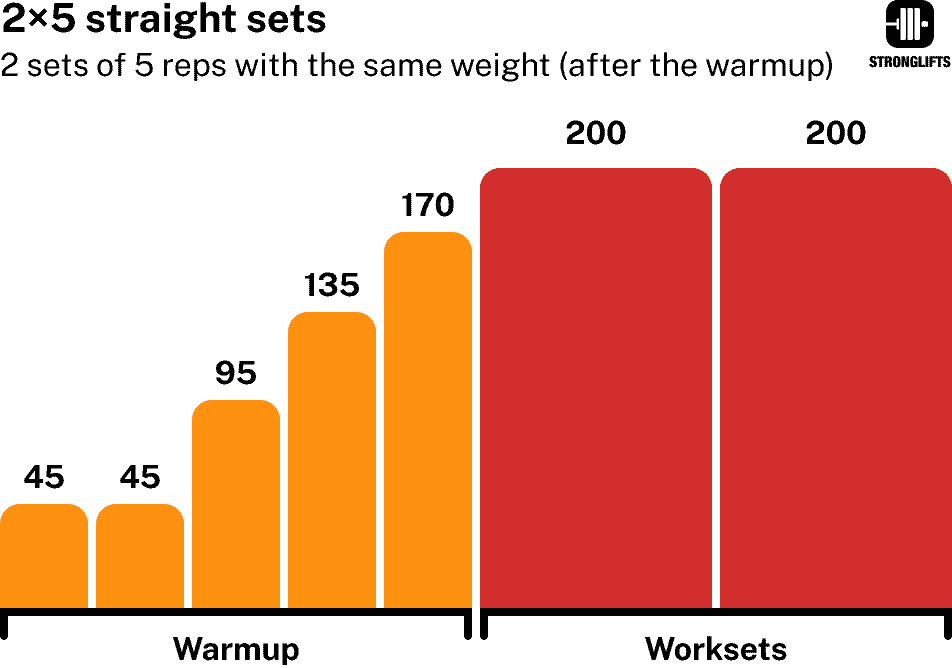
Once the weights become heavier you can switch to top/back-off sets – one heavy top set of five reps, followed by one lighter back-off set of five reps. The back-off set should be about 10% lighter than your top set.
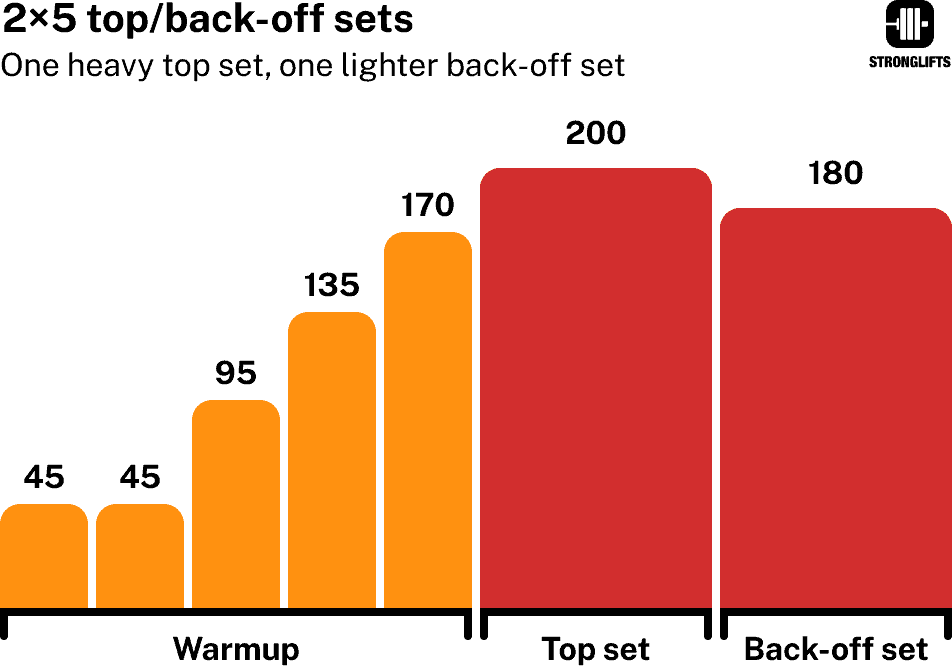
The strength and muscle gains are the same when doing top/back-off sets. But the workouts are less tiring, and you’re less likely to fail reps.
For more information, read the guide on top/back-off sets.
Workout Duration
Stronglifts 5×5 Mini is intended for busy lifters who don’t have time or energy for higher volume programs like Stronglifts 5×5. By doing only two exercises per workout you can finish in 30min even when lifting heavier weights. While the volume is low, it’s enough to maintain your strength and muscle size.
Let’s say you Squat 5x265lb (about 120kg). Here’s how long it would take you to perform your Squats…
| Squat | Rest time before | Execution time | |
|---|---|---|---|
| Warmup | 5x45lb | x | 30sec |
| Warmup | 5x45lb | 1min | 30sec |
| Warmup | 5x95lb | 1min | 30sec |
| Warmup | 5x135lb | 1min | 30sec |
| Warmup | 5x175lb | 1min | 30sec |
| Warmup | 5x225lb | 2min | 30sec |
| Top set | 5x265lb | 3min | 30sec |
| Back-off set | 5x240lb | 3min | 30sec |
| Total | 6125lb | 12min | 4min |
It would take you about 16min to complete a Squat session in which you lift 265lb or about 120kg on your top set.
These are very conservative numbers. Most warmup sets will take you less than 30 seconds to perform because they’re light and easy. That’s why you don’t need to rest between most warmup sets. Just add weight on the bar and do your next set. You only need to rest before doing your three heaviest sets of the day (the last warmup, top set and back-off set).
This leaves 14min to complete the Bench Press. Let’s assume a Squat:Bench ratio of 1.5 (1). Your Bench would be about 175lb with a 265lb Squat. Here’s how long it would take to Bench Press all your sets…
| Bench Press | Rest time before | Execution time | |
|---|---|---|---|
| Warmup | 5x45lb | x | 30sec |
| Warmup | 5x45lb | 1min | 30sec |
| Warmup | 5x95lb | 1min | 30sec |
| Warmup | 5x135lb | 2min | 30sec |
| Top set | 5x175lb | 3min | 30sec |
| Back-off set | 5x160lb | 3min | 30sec |
| Total | 3275lb | 10min | 3min |
13min to complete Bench.
Add Squats and you get 29min to complete the whole workout.
Again, these are very conservative numbers. For one, if you lift less weight than in this example, you’ll finish your workout faster because you’ll have less warmup sets to do. If you think these are too many warmup sets, do less or take bigger weight jumps, your workout will also be shorter.
The key to keeping your workout short is to move through your warmup sets quickly, and be strict with your rest periods. The Stronglifts app has a built-in rest timer. It notifies you when it’s time for your next set so you don’t waste time. It calculates your warmups and the weight per side. It saves you time and thinking so you can focus on lifting and finish your workout faster.
Program origins
The idea for Stronglifts 5×5 Mini came from the usual place: Stronglifters.
Many people build a lot of strength and muscle with Stronglifts 5×5. Some reach a point where they’re happy with their strength and body. They don’t want to gain more but not lose either. They just want to maintain their gains. And so I received many emails requesting a maintenance program.
A common reason for switching to maintenance is the need to focus on other things – work, family, studies, etc. Examples…
Age 38 95kg SQ 85 DL 90 OP 45 BR 60 BP 60. Love the app and your program. I had never lift weights up until 5 months a ago. Your app and programme have got me into the best shape of my life. But I am about to enter a really busy phase with work and may only have time to lift once or twice per week. Will this be enough to maintain what I have achieved or will I start to lose strength?
-Sam
I’ve done StrongLifts 3 years ago and got to a 365lbs squat 500lbs deadlift and 230lbs bench. I’m wondering how to restart. Also what’s a recommendation for a maintenance strength program so that I can focus on other things. I want to maintain a 315 squat 405 deadlift 225 bench and 135 overhead press once I reach that again.
-Dovid, USA
Others don’t want to spend hours in the gym to make small improvements. They can now Squat 300lb and have 15″ arms with visible abs. They know you get diminishing returns (2, 3, 4). They don’t see the point in training for hours like I do to add 50lb to their Squat or half an inch to their arms. They have more important things to do or just don’t like going to the gym. They’re happy with their progress, enjoy the benefits, and just want to maintain.
A common concern was therefore to not lose all the strength and muscle that they’ve built with Stronglifts 5×5. Examples…
Just wondering if you are coming up with an add on for when people have outgrown Stronglifts 5×5, or a workout plan for maintenance to keep up the strength that they’ve built.
-Eric, Canada
Hi Mehdi I was wondering if you’d incorporate a maintenance mode into the app. For once we reach desired strength, a mode where we can follow it to maintain strength without losing it.
Tyler, USA
Do you also have strength maintenance training plans? What do you recommend to stay at your current strength? I mean not losing any strength but also not gaining… just maintenance only. What would be your approach? How can I manage this in the App?
Jorgo, Netherlands
To be honest, I was surprised by the amount of requests for a maintenance program. In 25 years of lifting, it never occurred to me to try to maintain a certain level of strength. I’ve always tried to improve, even though it hasn’t been easy. It seems boring to me to just try to maintain. But I understand that not everyone is like me and that different people have different priorities.
My job was to come up with a simple training program that had the minimum amount of work needed to maintain the strength and muscle gains achieved with Stronglifts 5×5. This had to be an ultra minimalistic program that focused on the essentials and maintained the maximum amount of strength and muscle mass while taking the least amount of gym time.
Step one was to reduce the sets like on Stronglifts 5×5 Lite. This was important because they were lifting much heavier weights than when they started Stronglifts 5×5. This led to more warmup sets and longer rest periods which increased the duration of their workouts. Doing 2×5 instead of 5×5 and using top/back-off sets easily shortened the workouts by half.
| Stronglifts 5×5 Lite | |
|---|---|
| Workout A | Workout B |
| Squat 2×5 | Squat 2×5 |
| Bench Press 2×5 | Overhead Press 2×5 |
| Barbell Rows 2×5 | Deadlift 2×5 |
The problem was the Deadlift at the end of workout B. That’s still a long and hard session when you’re lifting heavier weights. Squatting 2-3x/week is also not necessary if your goal isn’t to gain more strength and muscle but just maintain the progress that you’ve already made.
Step two was then to switch to two exercises per workout to further reduce gym time. The three most essential movements are a push (Bench), Pull (Deadlift) and Legs (Squat). I dropped Barbell Rows because Deadlifts work the back. They don’t work it the same way but the goal wasn’t to chase perfection but keep the program practical. Perfect is the enemy of good. I added Overhead Press so there’s variety in each workout.
The program became Squat and Bench Press in workout A. Deadlift and Overhead Press in workout B. 2×5 per exercise.
| StrongLifts 5×5 Mini | |
|---|---|
| Workout A | Workout B |
| Squat 2×5 | Deadlift 2×5 |
| Bench Press 2×5 | Overhead Press 2×5 |
The volume is two-thirds to one-ninth lower than Stronglifts 5×5, depending on whether you do two or three workouts per week. Research shows that this is enough volume to maintain strength and muscle (5, 6, 7, 8).
This program is ultra minimalist. And so I called it “Stronglifts 5×5 Mini”.
Volume
Your training volume is the total amount of work you do for a movement or muscle. You can calculate it easily by counting the weekly sets.
Let’s compare the weekly volume on Stronglifts 5×5 with Stronglifts 5×5 Mini. We’ll assume three workouts per week for both cases. We’ll take the weekly average sets per exercise because they vary each workout (you alternate one week A/B/A with one week B/A/B).
| Weekly sets | Stronglifts 5×5 | Stronglifts 5×5 Mini | Difference |
|---|---|---|---|
| Squat | 15 | 3 | -80% |
| Bench Press | 7.5 | 3 | -60% |
| Deadlift | 1.5 | 3 | +100% |
| Overhead Press | 7.5 | 3 | -60% |
| Barbell Rows | 7.5 | x | x |
| Total sets | 39 | 12 | -69% |
The weekly volume of Stronglifts 5×5 Mini is 69% lower than on Stronglifts 5×5. You do 27 less sets per week. That’s one of the main reasons why the program takes less time, especially when you’re lifting heavier weights.
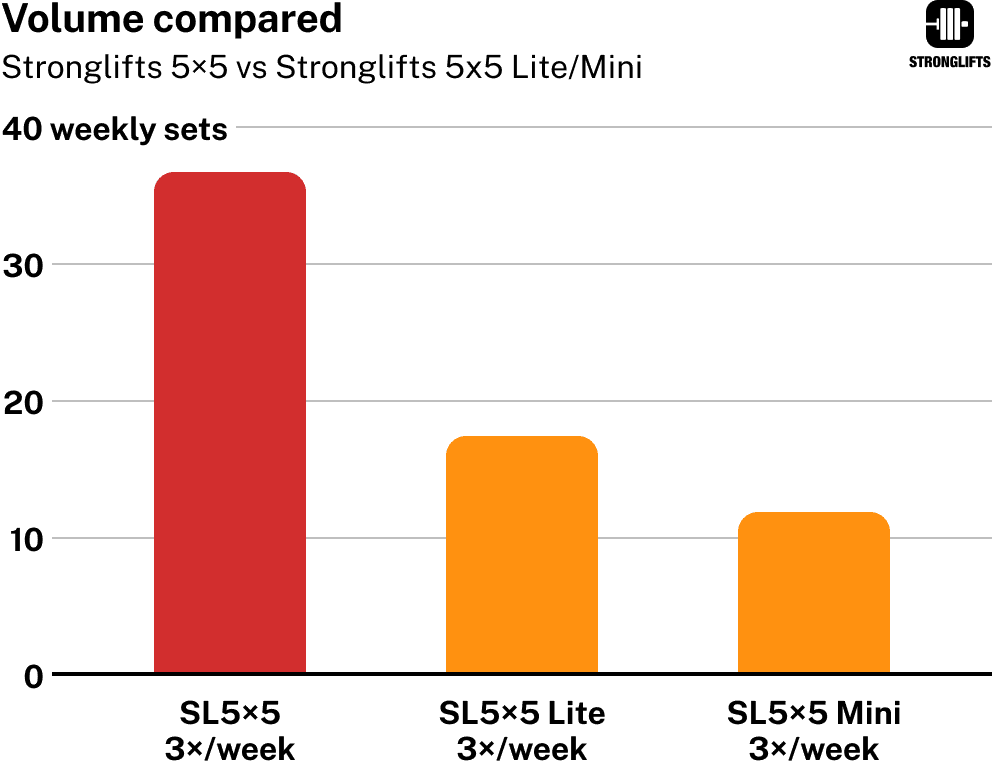
Many people hear that doing more volume builds more strength and muscle (9, 10). While that’s true up to a point, the typical mistake is to think that doing less volume does nothing. But as we’ll discuss below, the research shows that not much volume is needed to maintain strength and size (5, 6, 7, 8).
Stronglifts 5×5 Mini FAQs
Can I maintain strength with this?
Yes. Not much volume is needed to maintain strength.
For example, a study by Bickel et al found that leg strength can be maintained with as little as three sets per week (5). In this study they first made beginners train legs 3x/week for 16 weeks. Each workout they did three sets of Squats, Leg Press and Leg extensions. They then switched to maintenance mode where they only did one workout per week for the next 32 weeks.
| Bickel et al, 2011 | High Volume | Low volume (1/3) |
|---|---|---|
| Workouts | 3x/week | 1x/week |
| Squats | 3 sets | 3 sets |
| Leg Press | 3 sets | 3 sets |
| Leg Extensions | 3 sets | 3 sets |
| Weekly volume | 27 sets | 9 sets |
| Difference | -66% |
The volume during the maintenance phase was one third of that in the initial 16 weeks. Yet they were able to maintain and even improve their strength.
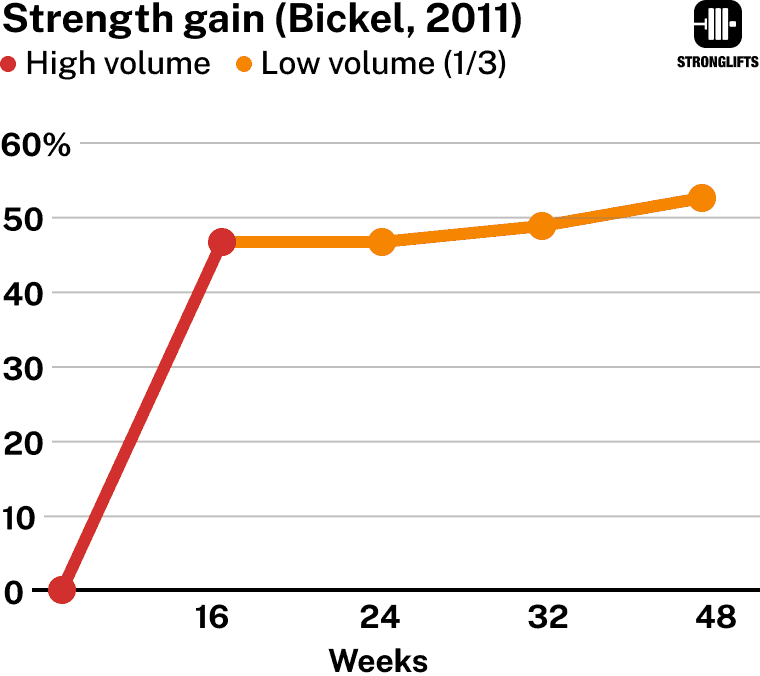
That’s not all. In the same study they also had another group of beginners do three exercises for three sets, 3x/week for 16 weeks. They then also did a 32-week maintenance phase where they did one workout per week. But they only did one set per exercise (5). Like this…
| Bickel et al, 2011 | High Volume | Low volume (1/9) |
|---|---|---|
| Workouts | 3x/week | 1x/week |
| Squats | 3 sets | 1 set |
| Leg Press | 3 sets | 1 set |
| Leg Extensions | 3 sets | 1 set |
| Weekly volume | 27 sets | 3 sets |
| Difference | -89% |
The volume of their maintenance phase was 89% lower. They only did three sets for legs per week. And yet they were again not only able to maintain their strength but make small improvements.
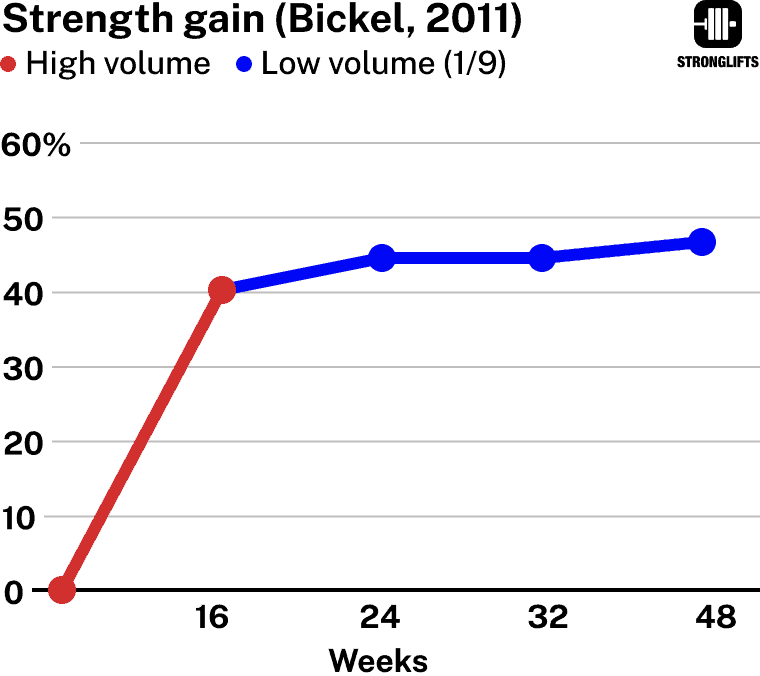
A study by Trappe et al found similar results (6). They had men aged 70 do three sets of leg extensions 3x/week for 12 weeks. They then did a 6-month maintenance phase with only one workout per week. The volume dropped 66%. Yet this was enough to maintain strength for six months.
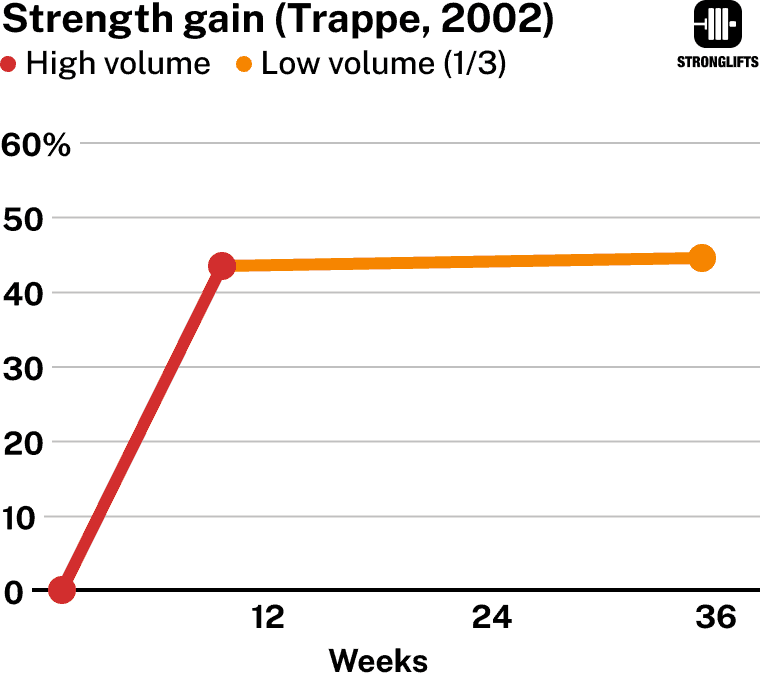
Another study by Tavares had people do Smith half-squats and leg extensions for eight weeks (7). They did three sets 2x/week for four weeks. Then they did four sets 3x/week for four weeks. After that one group did two sets 2x/week. The other did four sets 1x/week. This lowered the volume by 50-57%.
| Tavares et al, 2017 | High Volume | Low volume | Low volume |
|---|---|---|---|
| Workouts | 2-3x/week | 2x/week | 1x/week |
| Squats | 3-4 sets | 2 sets | 4 sets |
| Leg extensions | 3-4 sets | 2 sets | 4 sets |
| Weekly volume | 12-24 sets | 8 sets | 8 sets |
Here’s how the reduction in workouts and sets decreased the weekly volume for both groups…
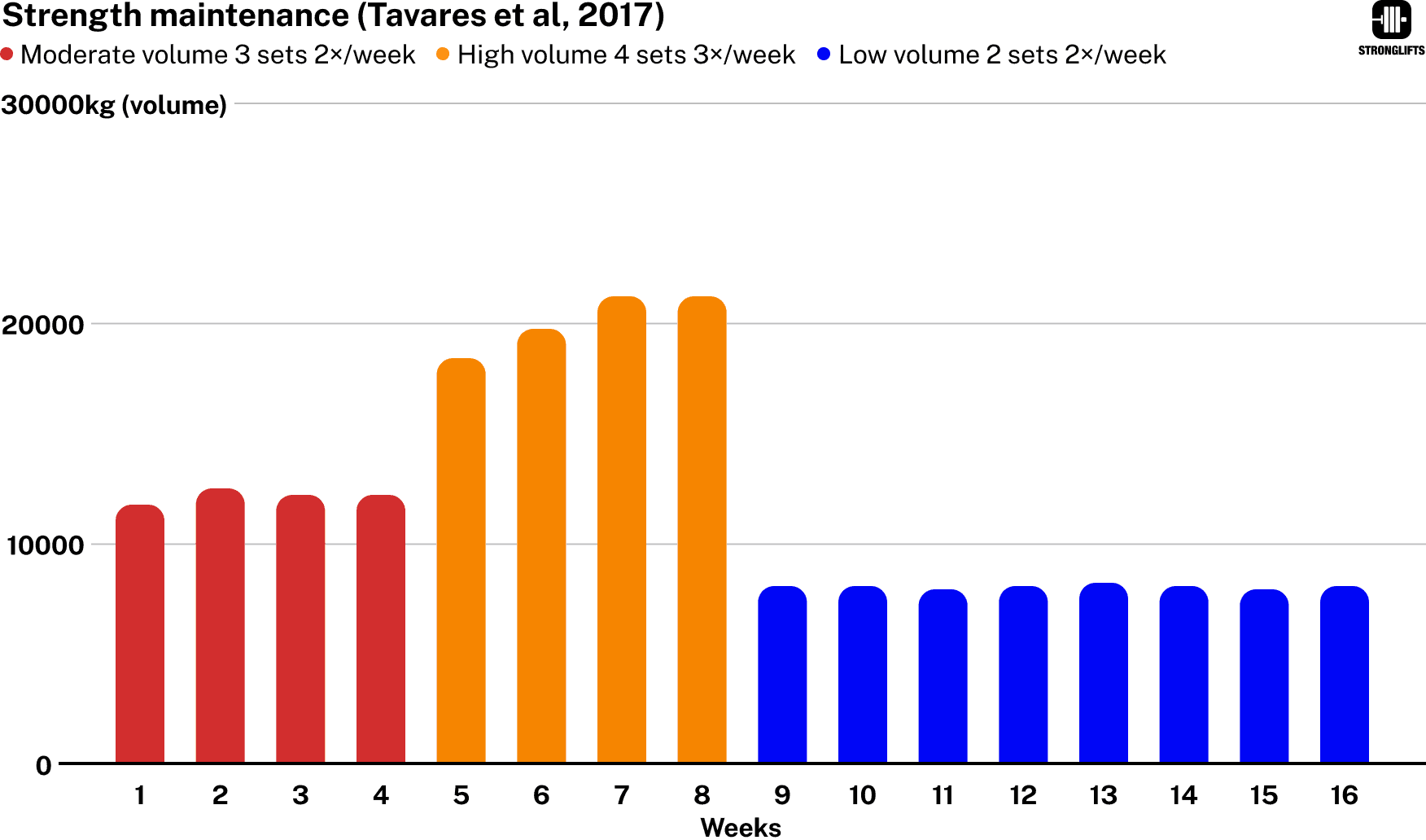
Despite doing half the volume, they were able to maintain all their strength. It didn’t matter if they did four sets 1x/week or two sets 2x/week. Their one rep max was actually higher after eight weeks of lower volume training. But this difference wasn’t statistically significant (it could just be chance).
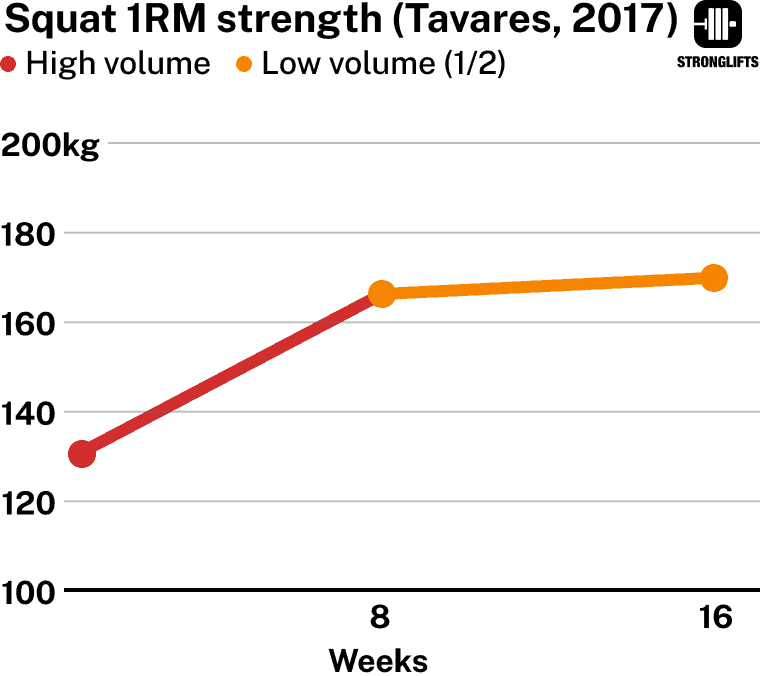
Finally, a study by Dr Pak et al found that just one hard set per exercise, done 2-3x/week, is enough for trained lifters to get stronger on the Squat and Bench Press over 8-12 weeks (8). With Stronglifts 5×5 Mini you do two to four sets per week on the Squat, Bench Press, Deadlift and Overhead Press depending on whether you choose to do two or three workouts a week. So you can expect to maintain all your strength or even slightly improve it.
You can log Stronglifts 5×5 Mini using the Stronglifts app. Just go to program, tap Stronglifts 5×5 Mini. The app will automatically plan everything for you.
Can I maintain muscle with this?
Yes. You don’t need much volume to maintain.
The studies mentioned above all looked at muscle retention when switching to a lower volume maintenance phase (6, 7, 8). All of them found that there was no loss in muscle size when doing 50 to 66% less volume.
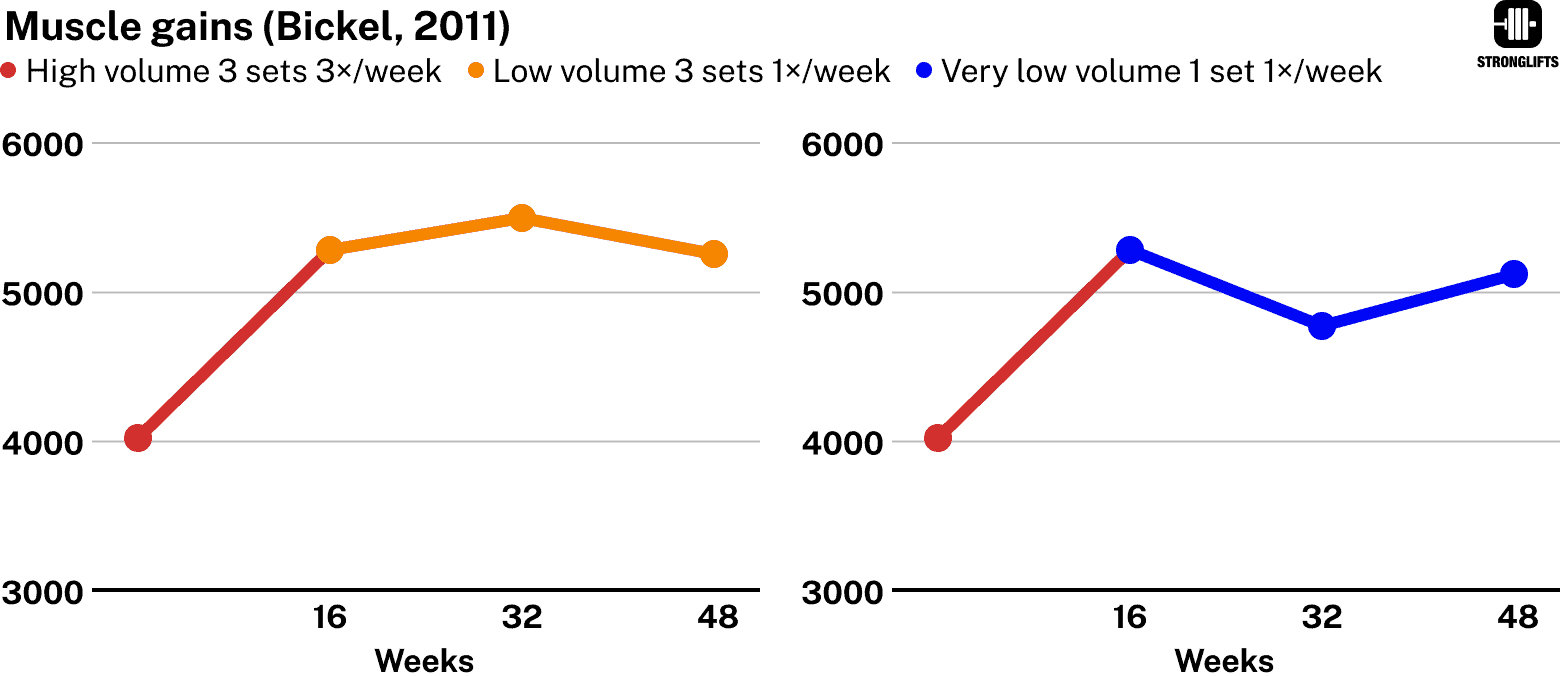
The study by Bickel et al did find a difference between younger and older adults (20-35 vs 60-75 years old) (6). Older adults seem to need more volume to maintain muscle size. Quote…
Our data are the first to suggest that older adults require more sets per week than younger individuals to maintain hypertrophy.
-Bickel et al, 2011 (6).
If you’re an older adult looking to maintain maximum muscle size, best is to do Stronglifts 5×5 Mini 3x/week. If you can only train 1-2x/week, then add sets to increase the volume. You can save time using top/back-off sets.
How long can I expect to maintain?
Strength gains can be maintained for 8 to 32 weeks when doing 50-66% less volume (5, 6, 7, 11). Here’s an overview of relevant studies…
| Bickel, 2011 | Trappe, 2002 | Tavares, 2017 | Rønnestad, 2011 | |
|---|---|---|---|---|
| High volume | 16 weeks | 12 weeks | 8 weeks | 10 weeks |
| Low volume | 32 weeks | 24 weeks | 8 weeks | 12 weeks |
| Volume drop | 66% | 66% | 50% | 50% |
| Workouts/week | 1x | 1x | 1-2x | 1x |
| Sets/week | 9 sets | 6 sets | 8 sets | 3 sets |
| Strength loss? | No | No | No | No |
These studies involved beginners with little gym experience, except for the one by Rønnestad et al which involved soccer players (11). Dr Pak et al studied intermediate lifters (8). They maintained and even gained strength doing just one hard set of Squat and Bench, 2-3x/week, for 8-12 weeks.
How to switch to Stronglifts 5×5 Mini?
You can switch from Stronglifts 5×5 to Stronglifts 5×5 Mini by doing three sets less per exercise, dropping the Barbell Rows in workout A, dropping Squats in workout B, and starting workout B with Deadlifts.
| StrongLifts 5×5 Mini | |
|---|---|
| Workout A | Workout B |
| Squat 2×5 | Deadlift 2×5 |
| Bench Press 2×5 | Overhead Press 2×5 |
You don’t need to lower the weight. The same weight will be easier to lift because you’ll do three sets less per exercise. This will result in less fatigue, and so you’ll be able to go heavier. If you weren’t doing top/back-off sets yet and start doing that too, this will also help you to go heavier. So you can expect to progress just from these changes, and despite doing less.
The Stronglifts app supports Stronglifts 5×5 Mini. Just go to program, tap Stronglifts 5×5 Mini. The app will update your workouts, exercises and sets while continuing your weight progress.
Why no Squats in workout B?
To keep the program short by having two exercises per workout max. Each workout you do exercise for your lower body, and one for your upper-body. You get a 50/50 split in volume for your lower and upper body.
If you do Stronglifts 5×5 Mini twice a week, you get 4 sets for your legs from Squats and Deadlifts. There’s no need to Squat every workout when your goal is to maintain strength and muscle, and not try to gain more.
Why no Barbell Rows?
To keep the program short.
The priority of Stronglifts 5×5 Mini is to maintain your overall strength and muscle using the least amount of volume necessary. Barbell Rows work the back which is trained with Deadlifts, and to some level with Squats.
If you want to have Barbell Rows in the program, you can add it or simply do the Stronglifts 5×5 Lite program.
Can I add assistance work?
You can if it doesn’t defeat the original purpose – to save time by doing the least amount of work necessary to maintain strength and muscle.
Assistance can be added to increase upper-body volume. The first way is to add Pullups and Dips for extra back, chest, biceps, and triceps work.
| StrongLifts 5×5 Mini with Assistance for Chest/Back | |
|---|---|
| Workout A | Workout B |
| Squat 2×5 | Deadlift 2×5 |
| Bench Press 2×5 | Overhead Press 2×5 |
| Pullups 2×8 | Dips 2×8 |
The triceps is already getting 6 sets per week from the Bench and Overhead Press if you do Stronglifts 5×5 Mini 3x/week. However there is no movement that involves bending your arms to work your biceps. So you may decide to instead add direct biceps work plus abs. Like this…
| StrongLifts 5×5 Mini with Assistance for Biceps/Abs | |
|---|---|
| Workout A | Workout B |
| Squat 2×5 | Deadlift 2×5 |
| Bench Press 2×5 | Overhead Press 2×5 |
| Barbell Curl 2×8 | Hanging Knee Raise 2×8 |
Women are usually concerned with different muscles than men. They’re rarely interested in growing their chest and biceps more, but looking to work their glutes and abs. Here’s an example of adding assistance work for this…
| StrongLifts 5×5 Mini with Assistance for Glutes/Abs | |
|---|---|
| Workout A | Workout B |
| Squat 2×5 | Deadlift 2×5 |
| Bench Press 2×5 | Overhead Press 2×5 |
| Romanian Deadlift 2×8 | Hanging Leg Raises 2×8 |
Here’s how the extra assistance work increases your weekly volume per muscle group on Stronglifts 5×5 Mini. I think adding Chest/Back gives you the biggest bang for your buck. It doubles the volume for these two muscles.
| Muscle | Main lifts | +Chest/Back | +Biceps/Abs | +Glutes/Abs |
|---|---|---|---|---|
| Chest | 3 | 6 | 3 | 3 |
| Shoulders | 6 | 6 | 6 | 6 |
| Back | 3 | 6 | 3 | 3 |
| Triceps | 6 | 9 | 6 | 6 |
| Biceps | × | 3 | 3 | × |
| Legs | 6 | 6 | 6 | 9 |
| Abs | × | × | 3 | 3 |
You can set all of this up in the Stronglifts app. Just go to program, tap Stronglifts 5×5 Mini – assistance work. Select the option you prefer based on which muscles you want to emphasize.
Can I do this once per week?
You can. But you may want to consider doing more sets to compensate.
For example, the study by Tavares et al tested maintenance phases of 2x vs 1x/week (7). Both groups kept the same amount of strength and muscle. It didn’t matter if they trained once or twice a week.
| Tavares et al, 2017 | High Volume | Low volume | Low volume |
|---|---|---|---|
| Workouts | 2-3x/week | 2x/week | 1x/week |
| Squats | 3-4 sets | 2 sets | 4 sets |
| Leg extensions | 3-4 sets | 2 sets | 4 sets |
| Weekly volume | 12-24 sets | 8 sets | 8 sets |
However, the group that only trained 1x/week compensated for that by doing double the volume. Instead of doing two sets per exercise, they did four.
You could do something similar with Stronglifts 5×5 Mini where you do double the sets and all exercises in one weekly workout. You then alternate the upper and lower body lifts. Like this…
| StrongLifts 5×5 Mini 1×/week |
|---|
| Workout A |
| Squat 4×5 |
| Bench Press 4×5 |
| Deadlift 4×5 |
| Overhead Press 4×5 |
The problem is that this workout will take a lot longer. You’re doing double the sets and exercises. This will also make this workout more tiring. 4×5 Deadlifts after Squats and Bench isn’t easy. You may find yourself too tired to work the Overhead Press properly after that. While it’s possible to do the same amount of volume in one workout, in practice you may find that you’re completing the latter sets with less effort, or simply skipping them.
If you decide to do Stronglifts 5×5 Mini once a week like this, make sure to use top/back-off sets. Do one heavy top set of five reps and then three back-off sets with 10% less weight. This will save you time by reducing your rest periods. It will also make the workouts less fatiguing.
Can I just do one set?
You can. But you better make it count.
The study by Dr Pak et al found that one hard set on the Squat and Bench, 2-3x/week, was enough to get stronger (8). But there was one important caveat – those sets have to be taken close to failure. Quote…
The results of the present systematic review suggest that performing a single set of 6-12 repetitions with loads ranging from approximately 70-85% 1RM 2-3 times per week with high intensity of effort (reaching volitional or momentary failure) for 8-12 weeks can produce suboptimal, yet significant increases in SQ and BP 1RM strength in resistance-trained men.
Androulakis-Korakakis, Patroklos et al, 2020 (8).
We can look at the RPE chart to find out how intense a set should be to reach the percentages from the study. The RPE chart tells you how many reps you could do at different levels of efforts (12, 13). My coach Mike Tuchscherer introduced the concept to the lifting community in 2008 (14).
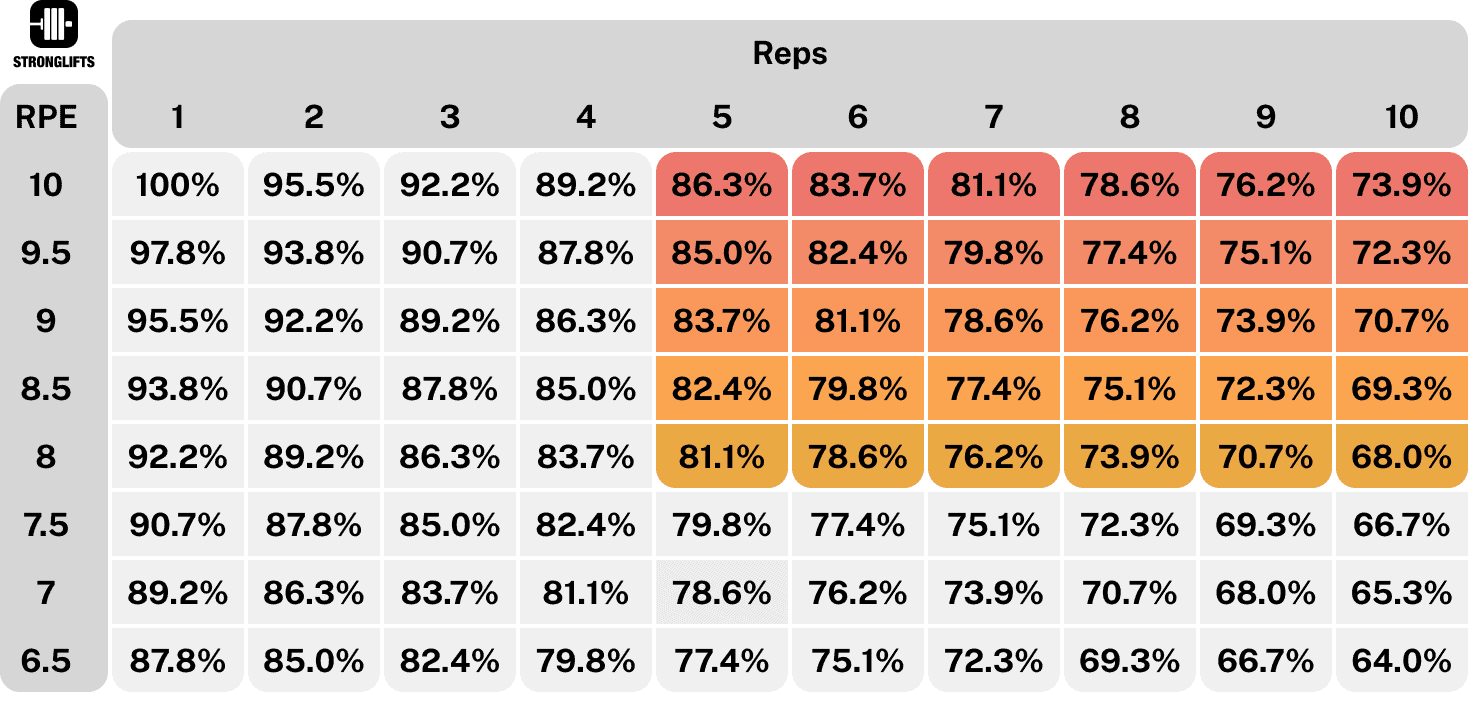
This chart shows that five reps at RPE 8-10 puts you in the 80-85% range. Five reps at RPE 8 means that if you went all out, you could have done two more reps. In other words: you could have done seven reps if you had taken the set to failure. If you tried an eight rep, you would have failed it.
| How many more reps could you have done? | RPE |
|---|---|
| None (max effort) | 10 |
| Maybe 1 | 9.5 |
| Definitely 1 | 9 |
| Maybe 2 | 8.5 |
| Definitely 2 | 8 |
| Maybe 3 | 7.5 |
| Definitely 3 | 7 |
| Maybe 4 | 6.5 |
Sets of five reps done at RPE 8-9 are intense. You may not reach failure but you come close. You therefore need spotters. Squat and Bench in the Power Pack with the horizontal safety pins in place to catch the weight if you fail. This allows you to train harder because you’re not afraid of failing.
Research shows that most people don’t lift heavy enough (15, 16). A study by Barbosa-Netto asked 160 lifters how much weight they usually Bench for 10 reps (15). They then made them Bench that weight to failure. The average lifter did 16 reps. Almost a quarter did 20 reps or more. Three quarters said that their main goal was hypertrophy – building muscle. Yet their training effort was too low to cause muscle growth. They didn’t lift heavy enough.
The study by Steele et al found that most lifters use 53% of their 1RM (16). That’s fine if you just started lifting. Stronglifts 5×5 starts with such low weights to ease you into training. But this isn’t heavy enough once you’re past the easy beginner gains. Quote from the study…
Participants selected loads equal to an average of 53% of 1RM across exercises. Lifting such a load coupled with a low-medium number of repetitions (e.g., 5–15) can sufficiently stimulate hypertrophy and increase maximal strength for novices but may not apply for more advanced trainees. Lifting such a load coupled with a higher number of repetitions and approaching or reaching task failure can be sufficient for muscle hypertrophy, but less so for maximal strength development, regardless of trainees’ experience.
Steele et al, 2022
For context: the American College of Sports Medicine recommends lifting with about 70% of your one rep max for increasing muscle mass (17). This means that the average gym goer is lifting 20% less weight than needed to build muscle. If you ever wondered why so many people in gyms don’t look like they lift, this is it. They’re just not training heavy/hard enough.
Stronglifts 5×5 Mini works differently than Stronglifts 5×5. With Stronglifts 5×5 you’re doing five straight sets of five per exercise at first. The first set is the easiest because you’re still fresh. It requires less effort to complete. But each set you do creates fatigue. This makes the next set harder to perform. Your effort goes up with each set. That’s why when people fail, it’s usually on the last set where the effort is the highest.
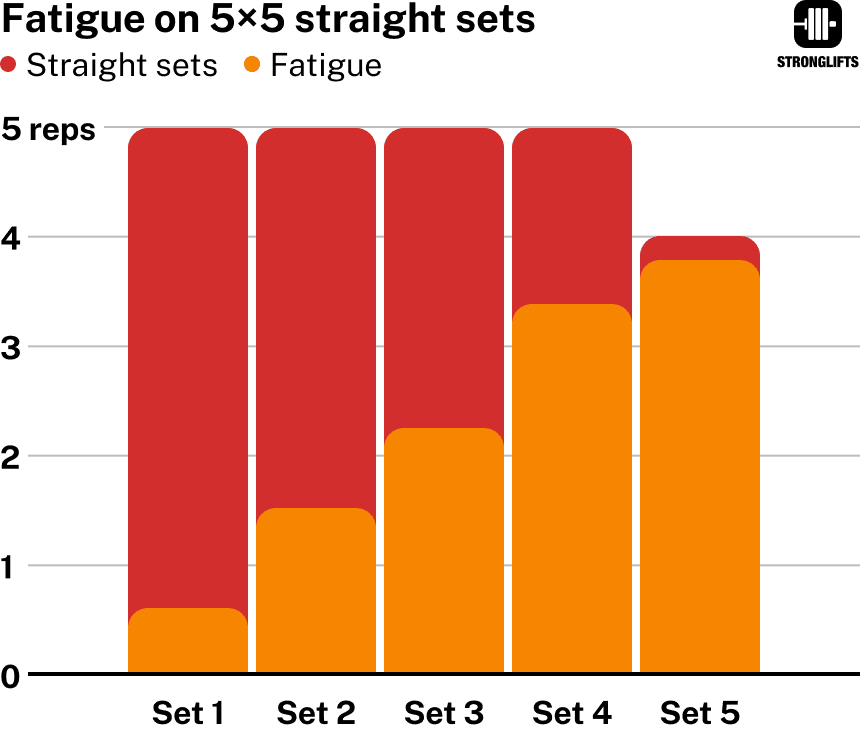
With Stronglifts 5×5 Mini you don’t have five sets to accumulate volume. You have two. If you only do one, you have to make it count to compensate for the fewer sets. You must take that set to RPE 8 at least. That means about ~80% of your 1RM and not 50% like your average gym goer. You’re already taking it easy by doing less sets and exercises. You don’t want to lift light and make it super easy. Effort is required to get results, especially when doing less.
But why only do one set? It won’t save much time. Doing a second set takes at most 30 seconds. Add 2-3min rest. Two exercises per workout. Skipping the second set would save about 5min. So you put in the effort of going to the gym, setting the equipment, doing all your warmup sets, and hitting your top set. But then you’re going to skip that one back-off set to save just 5min? Doesn’t make much sense to me. Just do two sets.
How should I progress?
Same as Stronglifts 5×5 – just try to add weight on the bar over time.
How to go back to Stronglifts 5×5?
Start by switching from Stronglifts 5×5 Mini to Stronglifts 5×5 Lite. Do that 3x/week for a few weeks. Give your body time to get used to doing more exercises and volume first. You can switch to Stronglifts 5×5 Lite in the Stronglifts app by going to program, tap Stronglifts 5×5 Lite.
After that switch to Stronglifts 5×5. You’ll need to lower the weight by about 20% so your body can get used to the extra sets that create more fatigue. You can stay at the same weight for a few weeks before you start to increase. Your goal is to first get used to the volume before you add weight.
Then switch to Stronglifts 5×5 Intermediate.
Are there program variations?
Yes, you can find them in the Stronglifts app. Just go to program, tap Stronglifts 5×5 Mini, select one of the templates.
You’ll find the 1x/week variation described above. You’ll also find several variations with different exercises. I recommend switching templates after doing Stronglifts 5×5 Mini for more than 8-12 weeks. This prevents boredom and can help you progress by making you focus on new exercises.
Is there a spreadsheet for Stronglifts 5×5 Mini?
Yes, just go to Stronglifts 5×5 Mini spreadsheet.
The spreadsheet is great for getting a big picture overview of how the program works, and how your weights will progress. But for logging your workouts in the gym, use the Stronglifts app. It’s easier to use, does all the math for you, and has lots of extra features like a built-in rest timer.
Join the Stronglifts community to get free access to all the spreadsheets for every Stronglifts program. You’ll also get 17% off Stronglifts Pro, and daily email tips. Enter your email below to sign up today for free.
References
1. Ball, Robert, and Drew Weidman. “Analysis of USA Powerlifting Federation Data From January 1, 2012-June 11, 2016.” Journal of strength and conditioning research vol. 32,7 (2018): 1843-1851.
2. Latella, Christopher et al. “Long-Term Strength Adaptation: A 15-Year Analysis of Powerlifting Athletes.” Journal of strength and conditioning research vol. 34,9 (2020): 2412-2418.
3. Appleby, Brendyn et al. “Changes in strength over a 2-year period in professional rugby union players.” Journal of strength and conditioning research vol. 26,9 (2012): 2538-46.
4. Counts, Brittany R et al. “Muscle growth: To infinity and beyond?.” Muscle & nerve vol. 56,6 (2017): 1022-1030.
5. Bickel, C Scott et al. “Exercise dosing to retain resistance training adaptations in young and older adults.” Medicine and science in sports and exercise vol. 43,7 (2011): 1177-87.
6. Trappe, Scott et al. “Maintenance of whole muscle strength and size following resistance training in older men.” The journals of gerontology. Series A, Biological sciences and medical sciences vol. 57,4 (2002): B138-43.
7. Tavares, Lucas Duarte et al. “Effects of different strength training frequencies during reduced training period on strength and muscle cross-sectional area.” European journal of sport science vol. 17,6 (2017): 665-672.
8. Androulakis-Korakakis, Patroklos et al. “The Minimum Effective Training Dose Required to Increase 1RM Strength in Resistance-Trained Men: A Systematic Review and Meta-Analysis.” Sports medicine (Auckland, N.Z.) vol. 50,4 (2020): 751-765.
9. Ralston, Grant W et al. “The Effect of Weekly Set Volume on Strength Gain: A Meta-Analysis.” Sports medicine (Auckland, N.Z.) vol. 47,12 (2017): 2585-2601.
10. Schoenfeld, Brad J et al. “Dose-response relationship between weekly resistance training volume and increases in muscle mass: A systematic review and meta-analysis.” Journal of sports sciences vol. 35,11 (2017): 1073-1082.
11. Rønnestad, Bent R et al. “Effects of in-season strength maintenance training frequency in professional soccer players.” Journal of strength and conditioning research vol. 25,10 (2011): 2653-60.
12. Helms, Eric R et al. “Application of the Repetitions in Reserve-Based Rating of Perceived Exertion Scale for Resistance Training.” Strength and conditioning journal vol. 38,4 (2016): 42-49.
13. Tuchscherer, Mike. “Beginning RTS.” Reactive Training Systems, 29 Nov. 2015
14. Tuchscherer, M. “The Reactive Training Manual: Developing Your Own Custom Training Program for Powerlifting“. Reactive Training Systems. 2008.
15. Barbosa-Netto, Sebastião et al. “Self-Selected Resistance Exercise Load: Implications for Research and Prescription.” Journal of strength and conditioning research vol. 35,Suppl 1 (2021): S166-S172.
16. Steele, James et al. “Are Trainees Lifting Heavy Enough? Self-Selected Loads in Resistance Exercise: A Scoping Review and Exploratory Meta-analysis.” Sports medicine (Auckland, N.Z.) vol. 52,12 (2022): 2909-2923.
17. Garber, Carol Ewing et al. “American College of Sports Medicine position stand. Quantity and quality of exercise for developing and maintaining cardiorespiratory, musculoskeletal, and neuromotor fitness in apparently healthy adults: guidance for prescribing exercise.” Medicine and science in sports and exercise vol. 43,7 (2011): 1334-59.




